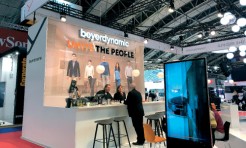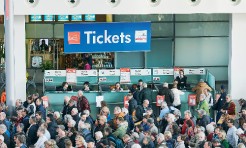Aktuelle Ausgabe
-
17.04.2024 Exhibition World Bahrain to Host 2nd Edition of Ghedex Bahrain 2024
Exhibition World Bahrain (EWB) will be hosting the 2nd edition of the Global Higher Education Exhibition “Ghedex Bahrain” on 21-22 April 2024.
-
12.04.2024 Hong Kong: Twin lighting fairs welcomed some 16,000 buyers
Organised by the Hong Kong Trade Development Council (HKTDC), the inaugural Smart Lighting Expo and 15th Hong Kong International Lighting Fair (Spring Edition) (Spring Lighting Fair) concluded successfully.
-
09.04.2024 Finland’s largest LED wall within a conference facility at Helsinki Expo
The Helsinki Expo and Convention Centre will undergo a significant renovation in the fall of 2024. The largest facility in the Conference Centre, hall 101, will be equipped with a new LED wall.
-
03.04.2024 NürnbergMesse celebrates its 50th birthday
NürnbergMesse is celebrating its 50th anniversary – and the City of Nuremberg is celebrating along with it.
-
28.03.2024 AMR 2024 concludes with strong results
The Auto Maintenance and Repair Expo (AMR) concluded on 23 March 2024 at the National Convention and Exhibition Center (Tianjin) with strong results in terms of the exhibition area, and number of exhibitors (1.061) and visitors (45.616 visits).
-
22.03.2024 ExpoTalent supports new business initiatives
Expotalent is a foundation initiated by three experienced professionals in the expo-events industry: Gert Jan van den Nieuwenhoff (Ahoy), Ids Boersma (RAI), and Ton Otten (Jaarbeurs).
-
20.03.2024 Exhibition World Bahrain hosts 1st Media Ghabga
Exhibition World Bahrain (EWB), the award-winning World’s Leading New Exhibition and Convention Centre for the year 2023, hosted its first Ramadan Ghabga for members of the media on Tuesday, March 19, 2024.
-
15.03.2024 UFI Asia-Pacific Conference unites exhibition industry leaders in Macau
Close to 300 delegates from 20 countries and regions attended the UFI Asia-Pacific Conference in Macau. The annual event was held at The Parisian Macao and hosted by the Macau Fair & Trade Association.
-
11.03.2024 Thailand affirms commitment to green future as host of Expo 2029
The International Association of Horticultural Producers (AIPH) has approved the rights for Thailand, a registered candidate, to host the 2029 International Horticultural Expo or “Korat Expo 2029.”
-
07.03.2024 AIPH International Horticultural Expos Conference in Doha
The International Association of Horticultural Producers (AIPH) is a global organisation uniting thousands of growers of flowers and ornamental plants. It is the approving body of International Horticultural Expos, such as Expo Doha Qatar 2023.
-
04.03.2024 ITB 2024: Switch Asia to Green seminar
Sustainability is more important than ever for European tourists, and Asian destinations are increasingly harnessing this potential.
-
28.02.2024 ADIPEC to take place in November 2024 in Abu Dhabi
ADIPEC will be held in Abu Dhabi on 4-7 November 2024, advancing tangible action across the entire energy value chain, accelerating decarbonisation and advancing the global energy transformation.
-
23.02.2024 AsiaWorld-Expo signs multi-year Diamond Sponsorship Agreement with UFI
UFI, the global association of the exhibition industry, and AsiaWorld-Expo have signed a multi-year Diamond Sponsorship Agreement, underlining AsiaWorld-Expo’s commitment to the ongoing development of the exhibition industry.
-
22.02.2024 IMEX Frankfurt responds with intention to the industry’s new needs
With a global range of exhibitors, learning sessions that dig into today’s most pertinent issues and opportunities to build new connections, IMEX Frankfurt 2024 is set to be a show with impact.
-
20.02.2024 Farnborough International invests in the brand behind The British Motor Show
Farnborough Internation has purchased a 48 per cent ownership of Automotion Events, the company behind The British Motor Show, to support the brand in growing its automotive portfolio.
-
14.02.2024 MyCEB enhances Malaysia’s business industry through regional idea exchange
Malaysia Convention & Exhibition Bureau (MyCEB) has made a significant stride in its commitment to elevate the nation’s business events industry.
-
09.02.2024 AUMA: Augsburg and Freiburg the latest to become new members
Augsburger Schwabenhallen Messe- und Veranstaltungsgesellschaft and Freiburg Wirtschaft Touristik und Messe are the latest new members of AUMA – the association of the German trade fair industry.
-
06.02.2024 UFI Global Barometer indicates that the exhibition industry will grow to record levels in 2024
UFI, the global association of the exhibition industry, has released the latest 32nd edition of its flagship Global Exhibition Barometer research which takes the pulse of the industry.
-
02.02.2024 Belgian manufacturing company beMatrix wins award for best stand design
Last night, beMatrix won the award for 'Best Stand Design' in the category of stands from 30 to 69 square metres.
-
29.01.2024 IOT Solutions World Congress to showcase the latest in disruptive technology to industry
IOT Solutions World Congress (IOTSWC), the leading global event on industry transformation through the use of disruptive technologies, will showcase the latest advances and trends in this field.
Software as a service to grow the exhibition industry!
16.06.2022
Ton Otten, director international at Jaarbeurs in Utrecht, sent us the following article with a few thoughts on the future of the exhibition business.
Today’s customers are very clear about their
needs: more marketing channels, more convenience, more relevance and a more
personalized experience. They want the right mix of in-person interactions,
remote contact and e-commerce self-service across the purchasing journey. To
meet these expectations we need to digitize all our processes and add new online
offerings to our customers. Offering services via "software as a service" (saas) is
the stepping stone to position the exhibition industry as a need-to-have in the
marketing mix of our customers.
“The future of B2B sales is hybrid! Since B2B buyers are using more channels, B2B sellers must, too” {McKinsey April 2022 [1]. Hybrid utilizes a combination of channels, including in-person, remote and e-commerce, to serve customers where and when they prefer. The shift toward more digital marketing & sales with a personal, or individual, touch was already quite prevalent, during the pre-pandemic period as a McKinsey’s research reflected in 2018.
“B2B customers not only intend to continue engaging remotely, as two-thirds prefer it to in-person interactions at many purchasing stages” {McKinsey April 2022}. In-person engagement doesn’t go away, but it is reserved for specific accounts and moments that matter, such as customers with complex needs, or for important opportunities, like buying a new product or solution. “Forty percent of B2B customers using a new supplier prefer to buy only if they’ve met the sales rep in person” {McKinsey April 2022).
The McKinsey research sounds pleasant for the producers of live-events and venue operators, who are facing a post-pandemic slow-start with an overall 60-70% occupancy level compared with the pre-pandemic figures. The supply-problems, China’s zero Covid strategy, the Ukraine war, the inflation, labor shortages etc. are some of the arguments used to explain the actual gap. And it must be said that is partly true. But there is more to explain like the ongoing disruption of our business and the lack of digital services.
The market share of providers of digital marketing & sales services across the customer journey, including remote and e-commerce providers, keeps on growing. But most of the leading shows weren’t affected as a result of the increasing global trade. Exhibitions continued their growth with exhibitors from the China/Asia region. There was no reason to invest heavily in digital technology to add value to the customer journey’s touchpoints. Similar to the car industry the upgrade of our products was enough to safeguard the income and high margins.
The pandemic has forced nearly every serious company to produce virtual event platforms. This experience has made business more receptive to its potential advantages like new audiences and new suppliers through that digital experience. The in-person experience is still seen as primary but it’s questionable if we will return to the pre-pandemic figures.
McKinsey researched that in-person meetings will continue but B2B suppliers and customers are going to be more selective. The value of offerings are increasing by customizing, individualizing and personalizing our services. So we need to integrate the in-person experience and virtual engagement features.
Buyers decide to attend a trade show principally to
find out the latest trends, identify industry innovations, and seek new ideas
(Diego Rinallo, 2017). Buyers want to develop relationships, share ideas, and
experiment with products (Diego Rinallo, 2006). If you want to respond to this
need an individual and more personalized approach is a necessity.
The pandemic period has proved that the personal
contact and a remote meeting are not interchangeable. Customers expect that we
demonstrate we know them on a more personal level when we communicate with
them. This forces us to organize our processes in a way that the timing of
communication, the offers and the content are relevant.
“To create the right analytics and insights along the entire customer journey, we need to be able to integrate consistent data into our data lake and blend it with data from other marketing and communication channels” {Stephen Rose, head of global communication services, Siemens}.
It’s not anymore questionable if there is a need for a personalized approach but there is a huge demand for it. Fortune 500 companies like Siemens are far ahead and their marketing and sales systems are ready for tailored messaging to the customers’ needs, offering relevant targeted promotion, sending timely communication tied to key moments, sending trigger based offers on the customers behavior, engaging and onboarding first time customers, show-up to their target group in the frequently visited websites/apps, celebrate customers milestones, etc.
We need to deliver at least the same opportunities to our key-target group and these are the Small and Medium Enterprises who are responsible for most of our revenue. We need to turn our collective marketing events into a personalized marketing journey, bottom-up instead of top-down!
From the perspective of our customers the exhibition was always one of many marketing instruments they used. But they were the passengers in our bus who picked people up once a year for a 2-5 day journey! Customers expect that we “Uberize”, and give them the opportunity to “rent a car” to ride their own journey. Of course they are welcome to use our common facility, the exhibition. But it isn’t necessary, many will do and many others won’t!
Our clients will be able to monitor and optimize
the customer journey of their own events. The exhibitions we offer are maybe
one out of many events they do each year. For all of this SME customers need professional
tools. We are able to offer these tools without being our own disrupter. It’s the opposite as we are “accelerating
trade” and by doing this staying
[1] The future of B2B sales is hybrid by Lisa Donchak, Julia McClatchy, and Jennifer Stanley. McKinsey April 2022.
Share in Facebook, Twitter or Google+:
TFI - Trade Fairs International - The International Trade Fair Magazine.
© 2006 - 2024 by TFI-Verlagsgesellschaft mbH. All rights reserved. TFI-Verlagsgesellschaft mbH shall accept no responsibility for the contents of external links and other contents.
TFI-Know-how
-
What to do when things go wrong at virtual or in-person events?

In the event world, it’s simply part of life if things don’t work out as planned.
-
How can networking be made to work at online events?

Networking typically happens at real, in-person events. But it’s also possible to do it online; it just works a little differently. There are various options available to organisers.
-
How can exhibitors stand out at trade fairs?

New products and a well-conceived stand design are not the only drivers for a successful presence. Many other factors are also important, but trade fair planners often lose sight of them.
-
How can industry decision-makers be reached online?

Trade fairs and trade fair companies need to constantly further develop, become more agile and flexible and offer services all year round. New, digital offerings are very important here. With its TrustedTargeting technology, Messe München offers its customers access to leading business-to-business decision-makers on the Internet.


